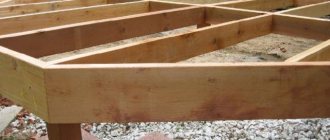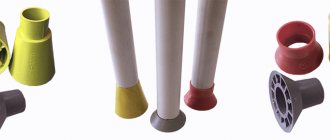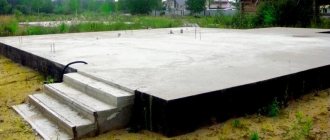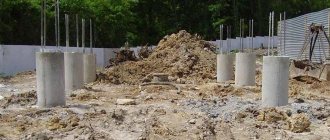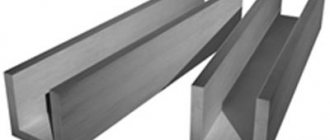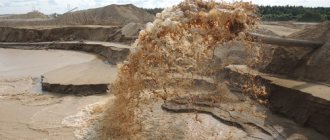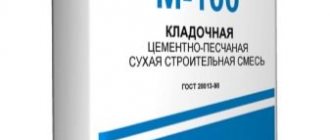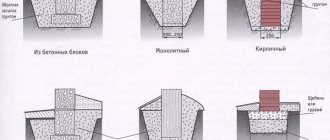Asbestos-cement pipes today are widely used in various areas of repair and construction work: installation of technical and drinking pipelines, storm drains, free-flow and pressure sewerage, stove and gas heating chimneys, ventilation and irrigation systems. Due to safety, durability and relatively low price, the use of pipes of this type is advisable in both large-scale and private construction.
Asbestos cement pipe - main advantages:
- Long service life
- Resistance to low temperatures, corrosion, rotting
- High level of durability
- Low price compared to products made from other materials
- Low thermal conductivity
- Good resistance to so-called “overgrowing”
- Light weight compared to similar pipes made of other materials
- Quick and easy installation
GOST 1839-80
Asbestos cement pipes are used to transport liquid working media by gravity. The diameters of asbestos-cement pipes are measured in millimeters, as is the wall thickness.
The exact characteristics and permissible areas of use of certain brands are regulated by GOST 1839-80.
Requirements that non-pressure asbestos pipes must meet:
- Ability to withstand pressure up to 4-6 atmospheres (the exact indicator depends on the class of the product)
- Resistance to longitudinal compression - pressure level is determined by diameter
- Homogeneity of the structure of the material itself – absence of delaminations, cracks, chips
- Exact compliance of the geometric dimensions of the product with the values specified in the passport documentation
When choosing a pipe, you need to focus on the parameters presented in the table:
During installation, pipes are laid using special couplings. In addition to installing various systems with gravity-flowing liquids, pipes can be used in the following way: gutters are made from BNT 100 pipes sawn along the axis, decorative fences, pillars, columns, flower beds are made, and they are chosen for the construction of chimneys.
Certificate of conformity
Cement-asbestos pipes are also used for pumping drinking water, which must be done in compliance with current hygienic and technical standards. For the installation and installation of pipelines, products for which a certificate of conformity has been issued are used. According to the requirements, the pipe must contain natural material with a permissible amount of radionuclides.
The certificate guarantees that the asbestos-cement pipe is safe from a radiation point of view. The document is issued after research has been carried out to determine the content of hazardous elements with radioactive influence. Thanks to special tests and inspection technology, conclusions are made regarding the safety of the material for humans and the environment.
Expert research is carried out in accredited laboratories, where asbestos-cement pipes are studied, and then a certificate is issued with a detailed description of these research results and the final conclusion. The certificate and the documents attached to it confirm the quality of the pipes and guarantee their safety.
Technical characteristics of pipes
According to their intended purpose, asbestos-cement pipes can be: gas, water, sewer. Depending on the operating mode of the product, pipes can be non-pressure or pressure. Depending on the brand, they can have different sizes: internal and external diameters, wall thickness, weight, load-bearing capacity, etc.
When choosing, you need to study the certificate of conformity and other accompanying documents, since a pipe that does not comply with the specified brand and its properties may result in the need to repair the network or completely change communications. Thus, free-flow cement pipes cannot be laid where heavy loads are expected and there is a requirement for high mechanical strength.
Asbestos-cement pipes can have very different diameters, weights, and loads, so before purchasing products and installing them, you must carefully study the characteristics.
Types of pipes and their parameters:
1)
Pressure pipe grades VT-6, VT-9
– can withstand operating water pressure of 6 and 9 atmospheres, respectively. The internal size is 100-500 millimeters, the wall thickness can be 9-43 millimeters, length - 4-5 meters, weight - 110-623 kilograms.
2)
Non-pressure asbestos-cement pipes
– can be 4-5 meters long, with an internal diameter of 100-500 millimeters, weighing 26-390 kilograms.
3)
For use in water and sewer systems
– length 4 and 5 meters, capable of stably withstanding a pressure of at least 4 atmospheres.
4)
For gas pipelines
– length (mm) standard, internal diameter can be 100-500 millimeters, wall thickness 11-36. From these pipes gas communications with excess pressure of up to 5 atmospheres are installed.
The weight of an asbestos pipeline is much less than a similar steel one, and the cost is 2-4 times lower. In operation, these pipes also demonstrate much better characteristics - they function normally when exposed to stray currents, and are not afraid of slightly acidic environments, alkalis, and moisture.
The surface friction coefficient of asbestos communications is much lower than that of similar metal products, which significantly reduces energy costs for pumping liquid media. An asbestos-cement pipeline has a low coefficient of expansion at temperature - when heated to +100C, the length of the pipe increases by only 0.4 millimeters (which is 12 times less than a similar steel one).
The thermal conductivity of an asbestos pipe is 140 times lower, which makes it possible to assemble systems at shallower depths without the risk of freezing. When asbestos drainage pipes are installed, it is possible to significantly reduce the cost of time, effort, and money for digging deep trenches and thermal insulation. Therefore, the use of such pipes in the installation of heating systems provides more advantages.
Terms of use
Asbestos cement is a fragile material that, if technology is violated, can crack and fall apart. When using parts, adhere to the requirements of SNiP. There are general recommendations to help you work safely with raw materials.
How to cut
Asbestos-cement pipes are produced in different sizes, but if necessary, the structure can be divided. During cutting, hazardous dust rises into the air. To minimize harm, performers must perform operations wearing protective respirators and goggles.
If you need to make a hole in a pipe, then an electric drill with a Pobedite bit is sufficient. When using conventional metal drills, the tools quickly become dull. The tip allows you to drill holes with a diameter of 10-12 mm. For holes from 12 cm, diamond or carbide models are used. The equipment is placed in shockless mode, otherwise the surface will burst.
The easiest way to cut the material is with a grinder. The tool works with products of different diameters and wall thicknesses, and the high speed of rotation of the diamond wheel will protect against chips and cracks. If you use a circular saw, then install a disk with carbide parts. One person should cut, and the second should water the cut area with water. The liquid minimizes the formation of hazardous dust.
Working with an angle grinderSource truby-moskva.ru
To work with large asbestos-cement pipes, a special cutter is used. The equipment is very large and expensive, so it is used by professionals in construction. A recess is cut around the circumference of the product, then the structure is placed on a roller and broken off. The technique allows you to put the division procedure on a stream.
Small diameter pipes can be separated with a hacksaw. To make the asbestos cement easier to give in to the blade, you need to make marks in advance and moisten the surface. The performer presses the device lightly, otherwise the material will burst. The technology is more time-consuming than using a grinder or circular saw, but little dust is generated.
If the diameter of the asbestos pipe used is small, you can use a regular ax. The marked surface is carefully struck with the instrument, applying equal forces and hitting the same place. The edges are not as smooth as when working with a hacksaw or grinder, but the procedure takes little time.
How to split a pipe evenlySource YouTube.com
Thin asbestos pipes are often cut using a slate nail. Marks are made on a strong surface, then holes are carefully punched along the cutting line. The more wells, the easier the part will come off. The product is placed on a wooden block and broken into holes.
How to connect
Due to their size, the assembly of main asbestos cement pipes is carried out in the area where the trench is located. If the elements are connected and moved in advance, depressurization is possible. Due to their fragility, only socket parts (fittings) are suitable for non-pressure models. The resulting gaps are filled with bitumen or clogged with tow.
Asbestos-cement pipes for high pressure are assembled using couplings. The parts have special grooves (recesses) that make it easier to insert rubber gaskets. The technology ensures the most hermetically sealed joining of elements that can withstand high pressure.
Parts for splicingSource tsw.com.ua
If you need to connect a plastic pipe to an asbestos pipe, use polyethylene couplings. The diameter of the part should be 5 mm less than the external diameter of the structure. The PVC element is kept in hot water for 10 minutes, then quickly put on the ends. The technology is suitable for models whose diameter is less than 300 mm.
Connecting element for constructionSource stroikoblevo.com.ua
If a pipeline made of asbestos and metal is connected, it is recommended to use cast iron models (“Zhibo”). The parts are carefully fixed to the surface of the structure and the bolts are tightened tightly. Removable elements can be removed at any time without changing individual pieces. Fasteners often rust in high humidity conditions, so they need to be replaced periodically.
When creating chimneys, you have to connect pipes made of asbestos-cement and metal. To prevent reinforced concrete from bursting when the steel is heated, you need a fitting (“Mangaplast”). The stainless steel adapter allows you to reduce the safe output temperature to 250 C and remove it from the boiler.
Pipeline installation
Installation of asbestos-cement pipes is understandable even for novice builders. When laying a highway, trenches are dug first. The size and depth of the ditches are specified in the project documents. The calculations take into account the freezing point of the soil, the purpose of the structure and the supply mode. For large pipelines, special equipment is used; for household ones, you can work with a shovel. To prevent parts from bursting due to deformation, the bottom of the ditch must be level, without a sharp difference in levels.
Before installation, the connecting sections of asbestos pipes are lubricated with a solution of graphite and glycerin. The liquid composition will make it easier to tighten the couplings onto the parts. Alternatively, use soap and water.
Each pipe should touch the ground a quarter of its diameter. It is forbidden to place supports made of wood or stones under the bottom of the structure. If the structure will be operated in conditions of high humidity, then drainage will be installed. Large models are laid using jacks.
Asbestos-cement pipe in a ditchSource vashcottage.ru
A coupling is mounted on the edge of the first element, the next one is placed without connectors, the third - with parts at both ends. To make a turn, you need to align the pipes correctly. The structure is connected every 5 m at an angle of no more than 3 degrees.
When installing a pressure structure, performers are required to monitor the condition of the grooves for seals on the couplings. Before installation, the recesses are cleaned of dust, the rubber bands are straightened and laid in the form of grooves. To prevent polymer parts from freezing in winter, they are brought into a warm room before the procedure begins. If the pipeline laying process is stopped for several days, then all ends are covered with plugs.
Chimney installation
The larger the outlet pipe, the greater the load from the wind it feels. If the structure is 2 m higher than the level of two roof joints, then the outer asbestos-cement structure is secured with special braces and clamps. The diameter of the element must match the parameters of the fire chamber, but not less than 12 cm.
Asbestos cement pipe on the roof Source delatbanyu.ru
If an asbestos-cement pipe is installed on a brick, then it is better to use spacer fittings. For a multi-channel structure, a distance of 10 cm is maintained between the elements. To protect against moisture, a slab is mounted on top. A separate outlet structure is secured every 0.5 m with clamps.
Option with an asbestos pipeSource pechiexpert.ru
A gap of 10 cm must be left between the pipe and the surface of the heated raw material. A support made of non-combustible material is mounted on the wooden roof. If it is necessary to extend the chimney, heat-resistant couplings (CAM) are used. The elements provide good sealing.
Price per meter
Asbestos-cement pipes offer fairly low prices along with excellent performance characteristics. Prices may vary depending on the brand, manufacturer, and region of sale, but are within an acceptable range.
Asbestos-cement pipes allow you to reduce costs not only due to the cost of the products themselves, but also during the installation process.
If steel pipes need to be laid at a certain depth, insulated, and installed using special equipment, then asbestos products require simpler requirements and help save time, money, and effort.
Non-pressure ventilation products
Installation of a stainless steel chimney
A common use of non-pressure asbestos pipes is for ventilation. Its construction begins from the basement. It contains two or more pipes. The pipeline installation on the roof is being completed. Installing products in the basement is necessary to create high-quality air circulation. The structures are placed relative to each other at a certain angle. This installation method provides a sufficient level of circulation.
The structures are placed at different heights. The product for fresh air circulation is mounted at a distance of twenty centimeters from the floor surface. The outlet structure is installed with the same gap, but from the ceiling. For ventilation to work efficiently, you need to free up space in the immediate vicinity of the pipes.
The upper part of the system is mounted at a considerable distance from the surface of the building's roof. This provides the most efficient level of traction. The ventilation system can be improved. To do this, you need to install fans. Devices can be of two types: injection and exhaust. This greatly improves the performance of the system. Asbestos-cement products are also widely used in the construction of chimneys.
Types of pipes
Asbestos-cement pipes are used in a wide variety of construction areas, performing various tasks. Two main types of products are distinguished according to their ability to withstand heavy loads of water - the liquid can flow by gravity or under pressure, which requires completely different parameters. In accordance with this factor, non-pressure and pressure pipes are distinguished; they can also be ventilation pipes used for the construction of fences, chimneys, etc.
Gravity
Very widely used in modern construction. They have a low specific gravity, resistance to corrosion, and the inability to withstand high and low temperatures for a long time. They can accumulate various substances that come into contact with their surface and are not afraid of stray currents.
Installation requires a minimum of time and effort; there is no need to install additional thermal insulation. Pipelines are resistant to fire, shock waves, and when exposed to water they can increase the level of strength.
Pressure
The pressure type is used where there is high water pressure. Usually they are used to install sewers, water pipelines, and heating mains. Also relevant for making ventilation systems and collectors; you can make a chimney out of them for a stove.
Requirements for pressure pipes:
- Finishing the ends in the form of a cone
- Passing tests to determine the ability to withstand a certain pressure and water transmission
- The presence of appropriate couplings, thanks to which it is possible to create a quick-release and durable connection
Subtypes of asbestos-cement products
Asbestos-cement pipes can be of other types, depending on their purpose. Thus, chimney systems are often made from grades that are resistant to high temperatures. There are asbestos-cement products for arranging garbage chutes, drainages, foundations, ventilation, cable installation, etc.
Pipes for fences have a long service life and are used as boundary columns to which any lattice material is attached with clamps. Asbestos-cement pipes can be used as casing pipes - for casing wells or during the construction of pile foundations.
When choosing, you must take into account the requirements and operating features, since asbestos-cement elements do not imply versatility and those used for sewer installation are not suitable for a chimney, for example.
Application
Asbestos pipes have a wide range of applications:
- installation of sewer lines (non-pressure);
- cold water lines (pressure products);
- cable channels for optical and copper wire networks laid underground;
- pipes can be used as piles for small private houses;
- installation of drainage systems (for this, the pipes are perforated along the entire length);
- chimneys for stoves and fireplaces.
Pressure water pipes and non-pressure sewerage are the direct and most common purpose of pipes made of combined materials. They also act well as a backbone for wired networks - they maintain optimal humidity conditions, sufficient tightness, and resistance to soil pressure and deformation.
Pipe piles for the home are an economical option for building small cottages. Hollow pillars are buried in the ground and filled with frame and concrete. Such supports are in no way inferior to columnar and pile systems.
The question arises: is it possible to use an asbestos-cement pipe for a chimney?
If you compare a chimney made of different materials, asbestos cement is not the best solution:
- the material can withstand heating only up to +300°C. Exceeding the temperature will cause the pipe to burst. For this reason, installing a chimney directly from the boiler is completely excluded;
- Condensation is a real problem with asbestos cement. The material absorbs moisture, which is saturated with fuel combustion products, and then released when there is a temperature difference. As a result, wet spots may “float” along the wall and roof. In addition, the caustic solution destroys the pipe walls over time;
- It is impossible to remove soot from the pipe, and it accumulates at a decent rate. As a result, it often ignites;
- installation of inspection hatches for pipe maintenance is impossible.
Also remember that asbestos is harmful to human health. Of course, the pipe can be installed outside the living space, where the smoke temperature is already acceptable. Nevertheless, the problem of condensation and soot removal remains relevant. The solution to the problem can be insulation and lining of the pipe.
Dimensions
The length can vary in the range of 3.95-5 meters. The throughput value can be: 100, 150, 200, 250, as well as 300, 400, 500 millimeters. Before determining the diameter, it is necessary to consider their two main types.
All asbestos-cement pipes and couplings for their installation are divided into two types: free-flow for sewerage (production is regulated by GOST 1839-48) and pressure for water supply (must comply with GOST 539-59). The internal and external diameters and wall thickness are indicated in millimeters.
The data is presented in tables:
Pouring asbestos-cement supports with concrete
The pouring height should be between 400 - 500 mm. To form a concrete cushion under the pipe, it must be raised to a height of 150 - 200 mm. This move will provide reliable support that will resist soil heaving.
As soon as the concrete has hardened, roofing material is laid on the outer surface of the pipe and the resulting structure is covered with river sand. It must be compacted, that is, it must be spilled with water and compacted. A cord is pulled between the installed posts and their horizontal installation is checked.
Before pouring concrete inside the pipe, reinforcement is installed into it. As a rule, these are steel rods that are connected to each other using wire jumpers. After the concrete is poured, the air is removed from it. To do this, you need to pierce the poured concrete several times with reinforcement. This operation is sometimes called bayoneting.
At this point, the pouring of piles ends and the time for technological downtime begins. It lasts about two to three weeks.
Installation and installation
Cement pipes are installed and assembled in different ways - it all depends on the scope of use, operating conditions and functions of the pipeline.
Couplings for connection: connection methods
In industrial plumbing systems, double-breasted couplings and asbestos cement are used, which must exactly match the pressure and diameter of the pipes. The connection is ensured by the part and the rubber O-ring. The characteristics of such couplings are often presented in tables with the parameters of different brands of pipes.
Elements in non-pressure systems are connected with chrysolite-cement couplings, which are made in the form of sections of thick-walled pipe of the required diameter. In the installation of gas and water pipelines, cast iron flange couplings of the “Zhibo” type are also actively used.
When creating a communication cable channel, free-flow pipes are mounted together with polyethylene couplings of the MPT type. Suitable for products with a diameter of 100-300 millimeters when laid in dry, normal soil.
Requirements for any type of connection:
- High strength and density under vacuum and under certain pressure
- Speed and ease of installation
- Resistance to various aggressive environments
Pros and cons of pipes
Among the main advantages of asbestos-cement pipes it is worth noting: low cost, strength, long service life, low hydraulic resistance, resistance to mid-range temperatures, the possibility of installation in open ground, resistance to corrosion, ease and speed of installation, a large selection of sizes.
The disadvantages include: insufficient heat capacity for powerful traction, ability to absorb condensate, heavy substances from gases, inability to use at temperatures above +300C, inability to clean due to the lack of hatches.
Asbestos-cement pipe is a popular product that is suitable for many tasks in the construction industry. Due to certain advantages and disadvantages, it is worth understanding that all properties of a pipeline depend on whether the pipe is suitable for a particular task. If the correct calculations are made and the product is adequately selected, the installed pipeline will be durable and of high quality.
Disadvantages of asbestos pipes
Despite its popularity in private construction, a chimney made from this material has many disadvantages.
The quality of the pipeline installation also matters. Let's consider the characteristic disadvantages of asbestos-cement chimneys and the reasons for their occurrence.
Burnout and bursting
Initially, the products were developed for mass production for use in land reclamation, construction of sewers and low-pressure gas pipelines. The designers did not provide for their operation at high temperatures. Emphasis was placed on tightness and ease of installation of highways.
The basis of the material is cement, and it is a porous material. It absorbs creosote, which is a flammable material. With strong heating, the process of its combustion begins, as a result of which the structure of the walls changes, they become thinner and burn out.
With further heating, the pressure of the air enclosed in the walls of the purlins increases. Products crack, burst and even explode.
Maintenance difficulties
The high strength of asbestos cement is a myth that many people want to believe.
Working with links requires increased caution and accuracy. The lack of steel reinforcement makes them extremely brittle and brittle, regardless of diameter and type
And that's not all...
Chimney maintenance is associated with the following difficulties:
- the need for regular cleaning, since pipes literally attract soot;
- the inability to make inspection windows to reach hard-to-reach areas;
- sensitivity of products to shocks and loads;
- Frequent replacement of insulation, which is destroyed by chemically aggressive condensate.
Humidification of the pipeline is fraught with unpleasant consequences, both for communications and for the building as a whole.
Condensate
The main purpose of the products was the laying of open and underground water pipelines of various lengths. Asbestos-cement pipes are resistant to water, but quickly collapse when in contact with chemically active liquids. They are the ones that form on the surface of the chimney during the interaction of soot and condensate.
The aggressive solution flows onto the roof and is absorbed into its surface. As a result, stains, unpleasant odors and cracks appear. Watching the video below will help you understand the extent of the damage caused by condensation. This issue can be resolved with the help of properly carried out insulation.
